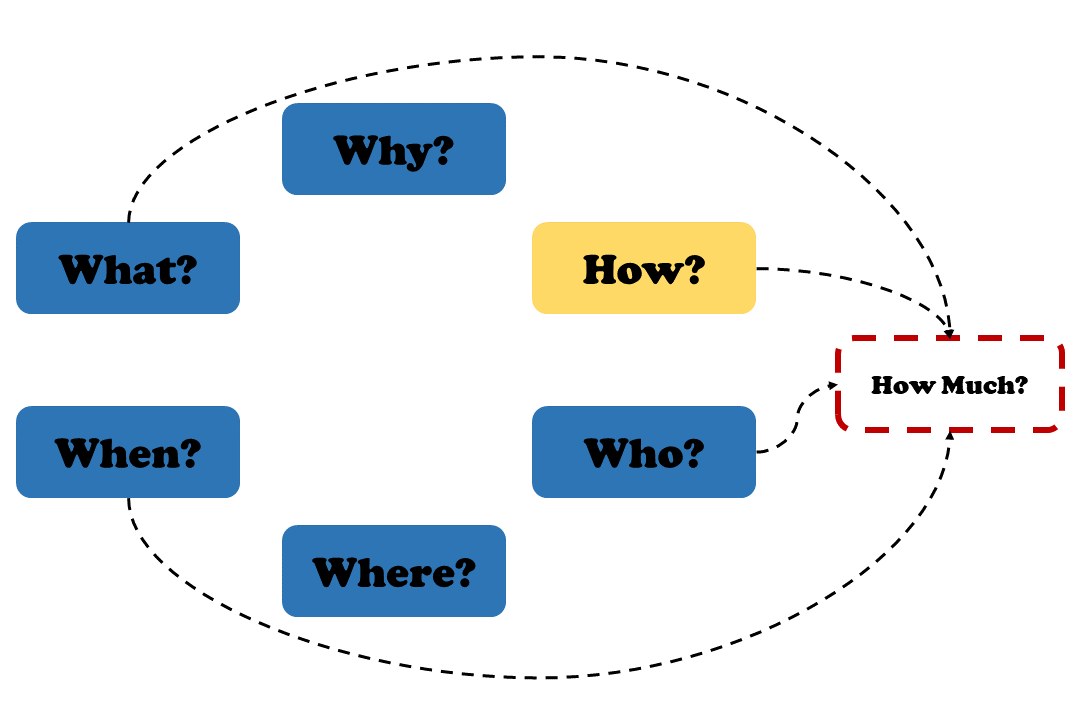We are used to working with certainties. We use too many “truths” that are, in fact, fragile, and we end up getting frustrated when those get crushed by reality. We need fewer certainties and more questioning.
I like to stir this discussion by listing the world’s 6 main questions. Yes, there are only 6 of them. They are “How?” “What?” “Where?” “Why?” “When?” and “Who?”.
5w1h or 5w2h?
In plain good English, those questions are known as the 5w1h. For instance, when we tell a story, those six questions must be answered for it to be complete.
A writer or a journalist, of course, is totally free to choose whether to leave out one or more of those questions deliberately. However, when planning the content, all of them must be answered.
Eventually, the management industry decided to include another question, “How much?” into this mix, and then it became the 5w2h.
Curiously, the original list dates back to the times of Aristotle. And the seventh question did list in there. Those were the Seven Circumstances of his famous book entitled The Nicomachean Ethics.
They were, more precisely, “Who?” “What?” “When?” “Where?” “Why? “In what way?” and “By what means?” The last two were merged into “How?”. For our point of today, let us stick to the 5w1h version.


Priority
Any list with more than two items must go through a prioritization screening. The law of prioritization is a confrontation with a traditional pressure model to do everything. Since we have, before us, a six-item list, we must therefore establish degrees of priority.
In dozens of circumstances, I went through this with audiences in classes, workshops, or speeches. Together, we prioritized the six-questions list with collective intelligence by applying the Dot Voting technique.
This method follows standards that repeat themselves regardless of the type of audience (small/big companies government agencies, Brazil, USA, Mexico, Portugal or France, etc.).
“Why?” was always the most important.
Voting after voting, “Why?” is the winning question. Sometimes, it even beats the runner-up hands down, receiving twice as many votes. This result is associated with the relevance of understanding purpose. And the purpose is nothing less than one of the three primary intrinsic sources of motivation for knowledge workers.
To our dismay, many of those who hire us as consultants can’t get past the second “Why?” when we explore what they do. In other words, they can’t answer the “Why?” that comes after the first “Because”. Another acclaimed author, Simon Sinek, claims that we must always start with the “Why?”.
“Why?”, “What?” and “Who?”
The runner-up is “What?”. Third place juggles the “Who?” “How?” and “When?” questions, the latter being usually predominant. Those are the exact three questions that the User Story format aims at answering.

Eventually, among the top three, we have “How?” and “When?”, which usually reflects the audience’s profile.
When the voters are more technical, “How?” makes it into the top-three. When most voters are project managers, “When?” stands out.
The chart below presents the results of 10 online polls carried out in 2020 with groups ranging between 17 and 33 people. Each person had the right to vote 3 times.
| Question (5w1h) | Group 01 | Group 02 | Group 03 | Group 04 | Group 05 | Group 06 | Group 07 | Group 08 | Group 09 | Group 10 |
|---|---|---|---|---|---|---|---|---|---|---|
| How? | 20 | 3 | 9 | 10 | 13 | 12 | 9 | 9 | 3 | 14 |
| Why? | 27 | 15 | 28 | 23 | 29 | 30 | 26 | 21 | 17 | 28 |
| Where? | 1 | 0 | 1 | 1 | 1 | 0 | 0 | 1 | 0 | 2 |
| Why? | 31 | 25 | 44 | 33 | 31 | 41 | 33 | 44 | 40 | 34 |
| When? | 8 | 1 | 6 | 8 | 6 | 4 | 9 | 7 | 6 | 11 |
| Who? | 12 | 7 | 10 | 11 | 5 | 7 | 9 | 10 | 5 | 5 |
“Where?
Just out of curiosity, I’ll share that “Where?” has come last every single time I ran this poll. Often, it had 0 votes. No one really wants to know “where” something happened.
Other reasons to use the “User Story” format
- Slicing: The User Story format invites us to slice the demand because it focuses on the needs.
- Customer-focused: Telling a story from the usage perspective makes all the difference. This is also a way to generate empathy for those who write, read, or work towards creating the solution.
- Empathy: Think of a good User Story. “I am John. As a student with visual impairments, I’d like to be able to use the Student’s Portal by myself because I don’t want to depend on other people”. By reading this, you can imagine a visually-impaired person using the company’s tool. Based on all the stories that will be sliced out of this one, the development team may feel empathy towards John. “Can John use the Student’s Portal on his own, without the help of others?”
- Independence: Contrarily to traditional formats of requirements, User Stories have a high degree of autonomy among themselves (with few exceptions). This allows us to prioritize with an increased focus on the return over investment (ROI).
Takeaway
There are many advantages in describing products and services specifications using User Stories. By using this format, we answer the most important questions of the universe. It also allows us to solve the problems that our customers and companies face.
Put some time aside to learn more about User Stories!
Read the following posts:
